Crematogaster (Atopogyne) depressa (Latreille)
  Type location Guinea (Formica
depressa, Latreille, 1802c: 268, illustrated, queen; Forel, 1910f:
5, male, no description), collected from the Coast of Guinea, by
Palisot de Beauvois - no type images on Antweb (January 2015) Type location Guinea (Formica
depressa, Latreille, 1802c: 268, illustrated, queen; Forel, 1910f:
5, male, no description), collected from the Coast of Guinea, by
Palisot de Beauvois - no type images on Antweb (January 2015)
subspecies
adultera (Crematogaster
depressa Latr. var. adultera n. var., Santschi, 1915c: 252,
worker) from Congo, Brazzaville, by A. Weiss - overall colour
yellow-brown, may be a distinct species - see linked page
fuscipennis
(Crematogaster depressa Latr., var. fuscipennis n. var.,
Emery, 1899e: 479, worker & queen; Forel, 1909b: 53, male, no
description; Santschi, 1910c, illustrated) from Cameroun (no
details) - see below
junior synonyms
platygnatha (Formica platygnatha nov.sp.,
Roger, 1863a: 168, queen, with its junior
synonym mandibularis (Cremastogaster mandibularis nov.
sp., André, 1889: 229, queen) from Sierra Leone - no type
images on Antweb (January 2015)
(see Bolton,
1995)  . .
Note: C. buchneri For.
subspec. foreli. nov. subspec., Mayr, 1895: 138, worker, from
"Slave Coast" - Guinea; has had various statuses and was
synonymized by Bolton, 1995: 153) is reverted here to Crematogaster
buchneri.
|
 Latreille's (1802c)
description of the queen is at Latreille's (1802c)
description of the queen is at  . Roger's (1863a) description of platygnatha
is at . Roger's (1863a) description of platygnatha
is at  . André's (1889)
description of the mandibularis queen is at . André's (1889)
description of the mandibularis queen is at  . Emery (1899e) provided
a drawing of the head of the major and the variety fuscipennis
(left). His description of the latter is at . Emery (1899e) provided
a drawing of the head of the major and the variety fuscipennis
(left). His description of the latter is at  . .
|
 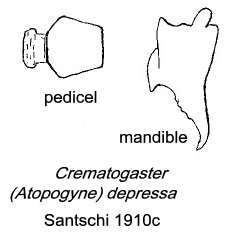 Santschi (1910c) in a
comparison with Cr. julienni had the drawing of the pedicel and
mandible (right). He also commented on fuscipennis and
described an ergatogyne worker - at Santschi (1910c) in a
comparison with Cr. julienni had the drawing of the pedicel and
mandible (right). He also commented on fuscipennis and
described an ergatogyne worker - at  (note the illustration
clearly was wrongly labelled, the mandible 8e seems to be that
of the female shown in 9b; 8c is the mandible of Cr.
(Oxygyne) margaritae). (note the illustration
clearly was wrongly labelled, the mandible 8e seems to be that
of the female shown in 9b; 8c is the mandible of Cr.
(Oxygyne) margaritae).
Santschi's (1915c) description of the dark
brown adultera is at  .
Two workers of what
appear to be this form from Congo are shown at the bottom of this
page. They have much more pronounced hairs and generally more
abundant erect pildsity and pubescence. .
Two workers of what
appear to be this form from Congo are shown at the bottom of this
page. They have much more pronounced hairs and generally more
abundant erect pildsity and pubescence.
|
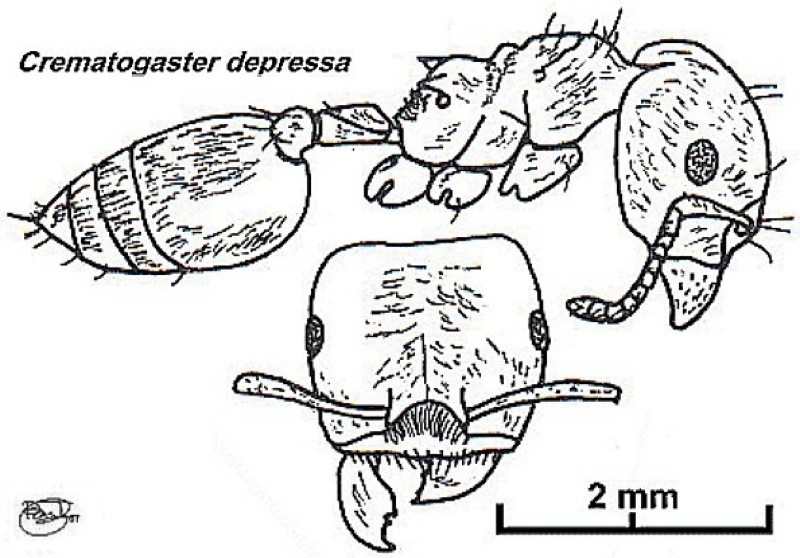 Nigeria specimens (Taylor, 1979: 39) WORKER.
Size
very variable TL 3.42-7.28 mm; largest HL 2.02, HW 1.80, SL 1.18, PW
1.00 Nigeria specimens (Taylor, 1979: 39) WORKER.
Size
very variable TL 3.42-7.28 mm; largest HL 2.02, HW 1.80, SL 1.18, PW
1.00
Colour dark chestnut brown. Dense pilosity, few erect hairs and only
four on the postpetiole. Mandible of largest worker with a concave
masticatory margin. Alitrunk profile rounded except in the metanotal
groove area where it is often raised. Mesonotal carina low. Propodeal
spines acute fairly stout and straight, down curved on the largest
workers.
Wheeler (1922) included records from Senegal, Guinea
(Los Islands), Sierra Leone (Mocquerys), Ghana,
Nigeria (Lagos, Olokemeji and Ibadan, by F.
Silvestri; Old Calabar, by H. Brauns), Cameroun (Victoria),
plus Congo areas. Santschi (1935) noted a specimen of fuscipennis
from Kisantu, Zaïre, collected by R.P. Vanderijst, i.1919.
Forel (1909b, 1911f) reported Zaïre specimens - foreli
from Luki, by Dr Jullien, fuscipennis from Kinshasa
[Leopoldville] by Waelbroeck and Dr Dubois, and "Congo" by Deleval.
From Guinea, Bernard (1952) described it as of
the western plains, on Mount Nimba found solely at Kéoulenta and
Yalanzou.
|
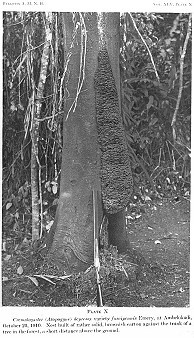 A common dominant species, constructing
large carton nests on major forest tree (see illustration from Wheeler,
1922, and "click", below left). Forages widely from the nest site onto
cocoa and any other adjacent trees. A common dominant species, constructing
large carton nests on major forest tree (see illustration from Wheeler,
1922, and "click", below left). Forages widely from the nest site onto
cocoa and any other adjacent trees.
In cocoa surveys in Nigeria (where it was not
separated from Cr. africana) it was found on 10-12% of trees,
throughout the cocoa growing area (Taylor, 1977; Taylor & Adedoyin,
1978). Earlier from CRIN, by Booker (perhaps on >10% of cocoa in
collections from two cocoa blocks, W13/2 and W18/1, Booker 1968).
In Ghana, Strickland (1951a) found that at CRIG
what he describes as the depressa-buchneri group was more
common (218 collections) than africana (27 collections) but
less so than striatula (778 collections). Bolton (1970-71)
listed it as one of the six most common carton-nesting Crematogaster
species on cocoa (simply at CRIG or in Ghana is not
clear) and noted that it was a common species. Leston (1973) also
regarded it as a dominant. It was found in only one cocoa canopy sample
by Room (1971) but Majer found it in 13.2% of his 144 pkd samples at
Kade, with 300-400 workers per sample (1975, 1976a, b, c). Bigger
(1981a) lists a number of cocoa surveys and these have little depressa
other than at Kade (Majer's results). However, it since has been
described as widespread by Belshaw & Bolton (1994b), who found it,
as a 'tourist', in leaf litter samples at six locations in the
semi-deciduous forest zone.
Strickland (1951a) added that the depressa-buchneri
group was essentially African, from Ivory Coast east to the
equatorial forests of Sudan.
In Cameroun it was by far the most common species in
the Campo forest canopy
surveyed by Alain Dejean and colleagues. It occupied 87.4% of the trees
and 85% of the vines, and its colonies reached several million workers.
They felt the large ecological success of Cr. depressa is
probably due to its ability to nest on trees with or without
extra-floral nectaries (EFN).
|
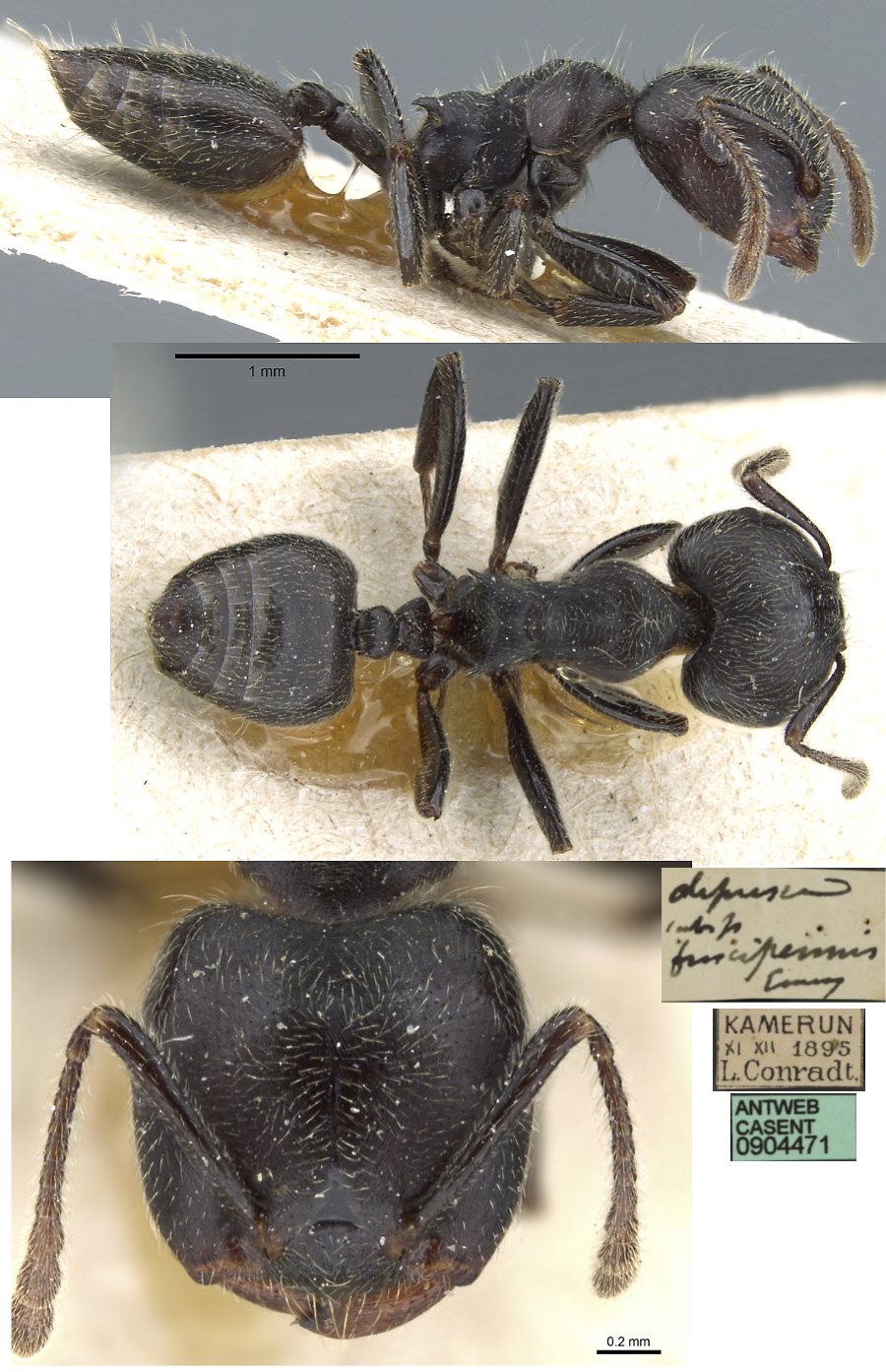 The
photomontage of a worker from the fuscipennis
type collection is collated from http://www.antweb.org/specimen.do?name=casent0904471. The
photomontage of a worker from the fuscipennis
type collection is collated from http://www.antweb.org/specimen.do?name=casent0904471.
|
Oxford University Museum
specimens
|
 The
photomontage is of a major worker from Cameroun; collectors McKey Wolbachia project (Cameroon 06). The
photomontage is of a major worker from Cameroun; collectors McKey Wolbachia project (Cameroon 06).
|
 The
photomontage is of a major worker from Benin, Agonlin;
collector J-F Vayssieres (RVA 301). The
photomontage is of a major worker from Benin, Agonlin;
collector J-F Vayssieres (RVA 301).
|
 The
photomontage is of a media 1 worker from Benin (RVA 301). The
photomontage is of a media 1 worker from Benin (RVA 301).
|
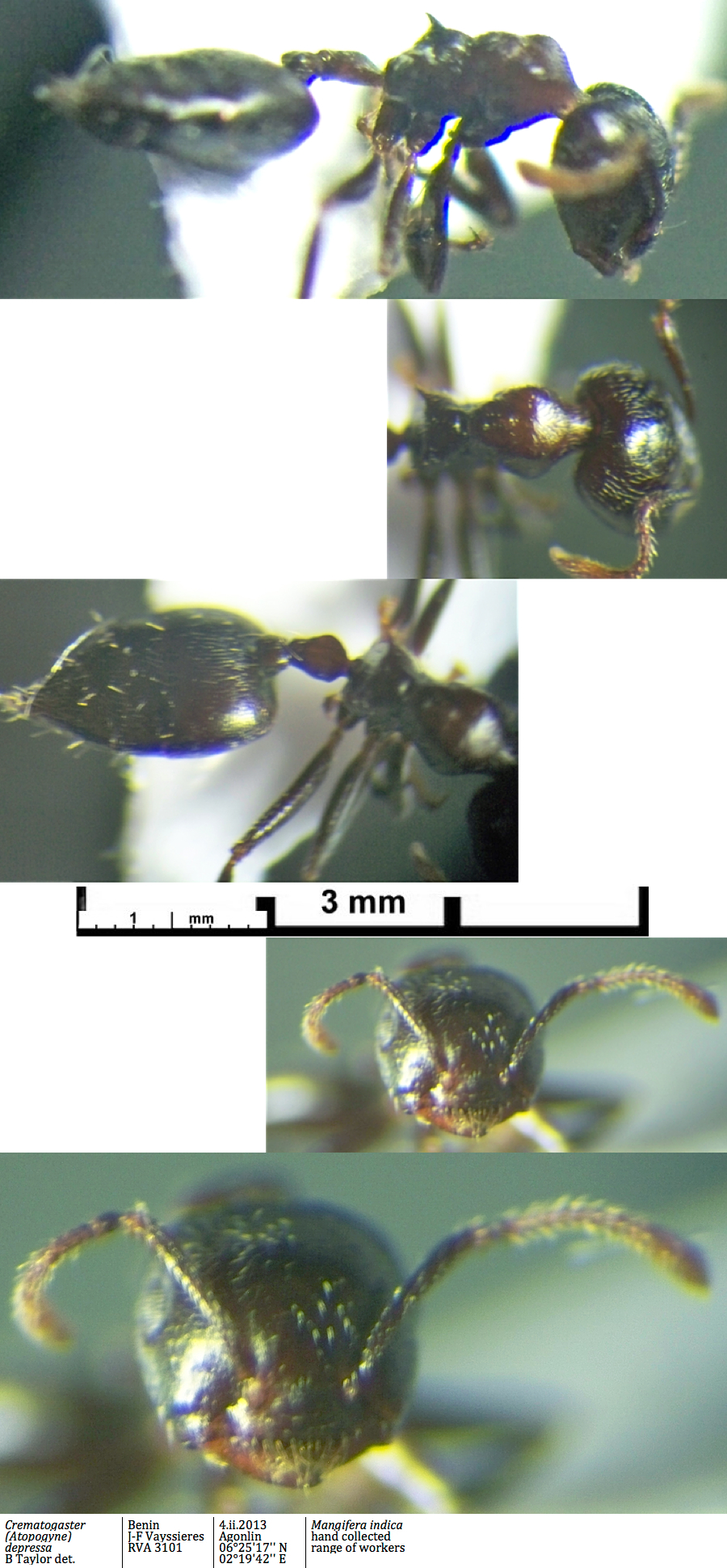 The
photomontage is of a media 2 worker from Benin (RVA 301). The
photomontage is of a media 2 worker from Benin (RVA 301).
|
 The
photomontage is of a minima worker from Benin (RVA 301). The
photomontage is of a minima worker from Benin (RVA 301).
|
|